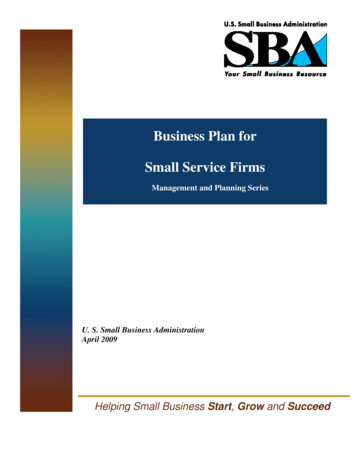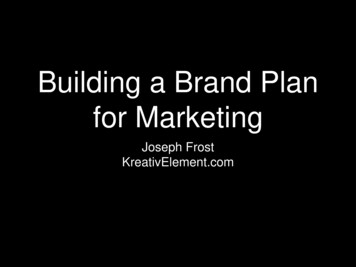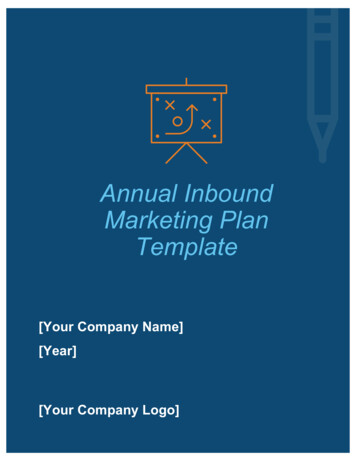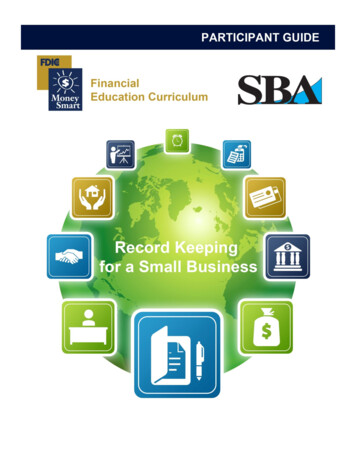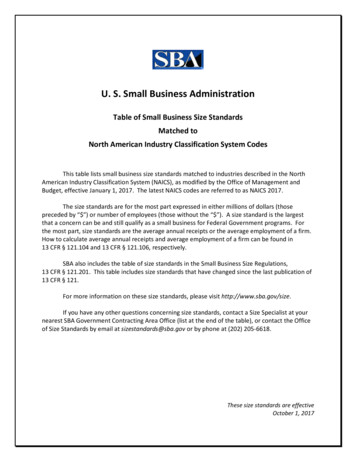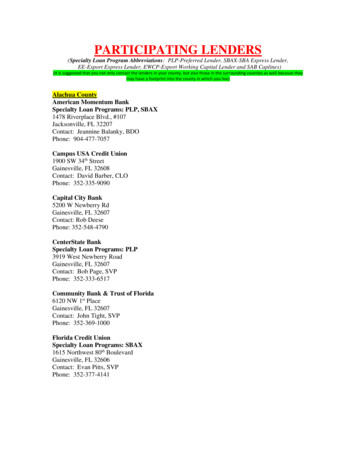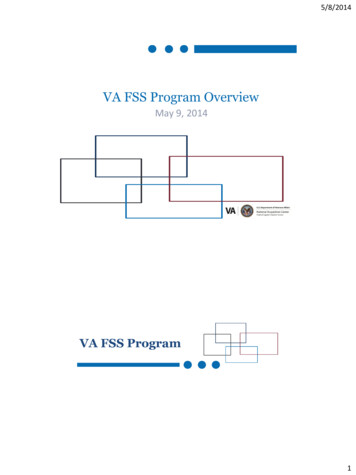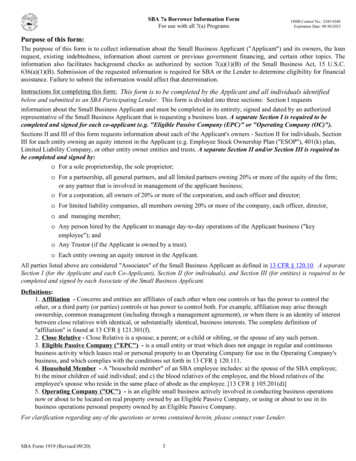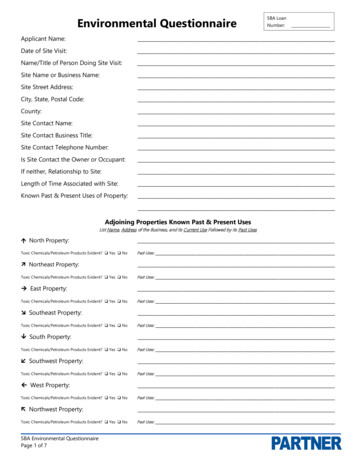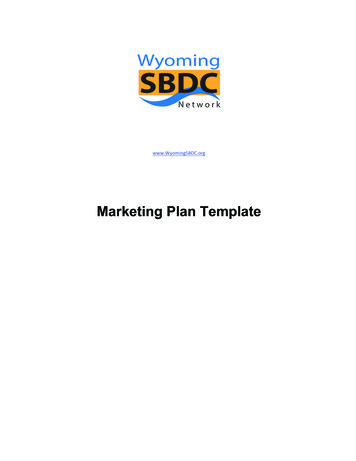
Transcription
www.WyomingSBDC.orgMarketing Plan Template
INTRODUCTIONThe following pages contain detailed information on how to write a marketing plan for your business.Your marketing plan is a vital part of your overall business plan and strategy. Our hope is that thisoutline will help you think through aspects of your proposed business operations and the channels youwill use to reach your target market that you may not have yet considered. Depending on the kind ofbusiness you are planning, some of the information may not be relevant. If this is the case, feel free toskip or adapt parts of the plan to fit your business model. The Microsoft Excel worksheets have beenincluded to assist you in gathering information. You can complete and incorporate them as part of yourplan; include them in the Appendix and use the information to write sections of the plan, or skip thementirely.NOTE: Some of these worksheets have been “Protected” in order to retain the formulas. If you need toincrease column width, you will have to “Unprotect” the sheet. Click on Excel “Help” to learn how to dothis. Cells that require text entry will expand to hold all text that you enter.WHY WRITE A MARKETING PLAN?Whether you are just starting your business or thinking about growing your operations, a good marketingplan includes everything from identifying your target customers to how you will reach them to how you willcreate repeat buyers. Your marketing plan is the roadmap you will use to get unlimited customer loyalty andimprove the success of your organization.1
I.Executive SummaryA. Brief description/overview of your marketing plan – write this section of your plan lastII.Products/ServicesA. Clarify exactly what your business offersIII.Target CustomersA. Identify your target customer and their characteristics that would make them interested inyour product or serviceIV.Unique Selling Proposition and Competitive AnalysisA. Identify what makes your product or service unique. What problem are you fixing for yourtarget customer that your competition is not?B. Identify your direct and indirect competition. How will your business be different?V.Pricing and Sales Volume PotentialA. Identify how you will price your product or serviceB. Identify your sales volumeVI.Location AnalysisA. Where will your business be located? How will this impact your pricing and sales volumepotential?VII.Marketing StrategiesA.B.C.D.VIII.PackagingDistribution – How will you communicate about your product with your target customer?Promotion, Advertising, Direct SellingCustomer ServiceJoint Ventures and PartnershipsA. Identify partners who can help maximize your access to new customersIX.Retention StrategyA. Identify what you will do to gain returning customers to your businessX.Financial Projections and Goal SettingA. Identify your marketing expenditures and projected revenue based on these effortsB. Set realistic and tangible goals to evaluate your marketing success2
I.EXECUTIVE SUMMARYWritten last, your executive summary is a summary of all of the other sections of your marketing plan. Yourexecutive summary will give you and other parities (employees, advisors, lenders, etc.) an overview of yourplan.Remember, this could be the first time your audience learns about the unique value proposition of yourbusiness. Be enthusiastic, professional, complete, yet concise.II.PRODUCTS/SERVICESClarify exactly what your business offers and your plans for the future direction of the business. Suggestedlength is one or two paragraphs. III.Describe the products and/or services you offer in detail.If you are expanding a current business, describe any new products and services you plan tooffer in the future. Are they an extension or expansion of your current offerings, or are theycompletely different? Will they change the definition of your business? Are they add-on offeringsfor your current customers, or will you be seeking a new market to buy them?Explain the features of each product/service and what benefit those features will bring to yourcustomers. Features are characteristics of your product/service. Benefits are what will promptthe public to buy from you. Be certain that your claims are truthful, verifiable, and meaningful.For example, a feature of your business might be free delivery. The benefit of that feature to theconsumer will be convenience.Is there seasonality to your business? If so, explain and discuss how you will handle unevenseasonal cash flow.Describe your future growth plans.Add any other information about your product or services you think is importantTARGET CUSTOMERSDescribe your target market. Who is currently buying or most likely to buy your products and services in thefuture? Is your market a specific segment of the population or the entire population in general? What are thesize, location, and characteristics of your potential market? If you have more than one target market, pleasedescribe each market. For greatest success, you want to focus your marketing efforts on the individuals ororganizations that are your best customers. Suggested length is one or two paragraphs for each targetmarket.For products and services aimed at consumers: Describe their general demographic characteristics, paint a picture of your current customers.How old are they? What sex are they? Where do they live and work, and what is their incomelevel? What other characteristics do they share? What are their lifestyles, interests, beliefs?Describe your market's behavior patterns and attitudes (psychographics). Where do they shop?What do they read? What else do they buy? For new businesses, you can find much of thisinformation from the U.S. Census Bureau, your local Chamber of Commerce, and/or your localSmall Business Development Center.Your main goal in this section is to paint a picture of your ideal customer. Later in the plan, whenyou discuss marketing channels, having a clear picture of who you are selling to and whatmakes your products or service different than the competition, will help you write your marketingmessaging. How large is your market? Provide some numerical estimates based on research. How manycustomers do you expect to serve each week or each month? How often will they buy? Howmuch will they spend? Is the market growing or shrinking? This information is very important as3
III.the basis of your sales volume forecast. If there is recent U.S. Economic Census data available,this is a good source for information on gross sales for establishments in your industry located inyour area.Describe possible future market expansion. Generally, a business can expand its market reacheither by adding new products or services that will attract new customers, increasingsales/marketing efforts for current products, or expanding into new geographic areas.UNIQUE SELLING PROPOSTION AND COMPETITIVE ANAYLSISUnique Selling PropositionYour unique selling proposition, also known as your competitive advantage, is the one thing that makes yourbusiness’ products or services do better than the competition. What makes your business unique? What painpoint are you fixing for your target customer?For example: You own a high-end chocolate shop. You have two target customers: (A) Young, workingprofessionals and (B) partners of chocolate lovers. Your first customer segment enjoys receiving notificationsof new chocolate flavors and offerings, comes to weeknight “wine and chocolate” events, and likes to be amember of a preferred customer program. Your second market segment tends to shop last minute,appreciates the ease of pre-made chocolate boxes, and loves a reminder of what is their sweetheart’sfavorite flavor.Though you are still a high-end chocolate shop, your unique value proposition for each of these customers isdifferent. For Customer A, you are offering a local and luxury chocolate experience. For Customer B, you areoffering quality and ease of transaction.For each different customer market that you identify, you should also be able to identify a unique sellingproposition that is specific to that target customer.What makes your business different from your competition?Competitive Analysis and PositioningDescribe your competition, both direct and indirect; this will help you identify what makes your businessunique. Direct competitors sell products and services similar to yours. Indirect competitors sell products andservices that are substitutes for yours. All businesses have both direct and indirect competitors. Your goal isto identify others competing for the same market, get ideas about good practices you should adopt, andavoid competitors' errors. Competition is not a bad thing. Being unable to identify or differentiate yourselffrom the competition is! Analyze your competition. List your competitors. Compare their products and services, prices,quality, advertising, management, location, customer service, marketing, reputation and image,etc. to your planned business. What special features and benefits do they offer? Think abouthow you will compete. Does your competition utilize sustainable business practices? What is theincome level of their customers? Are your competitors large chains or small independentbusinesses? Be honest! Be specific! Steer clear of broad, generic statements.Describe indirect competition to your products and services. Who specifically offers them? Whatdo they charge? What special benefits do they offer?Briefly compare your products' prices, quality, and special features, your image and location,and the income level of your customers to your competitors. Explain where yourproducts/services “fit” within your industry.How will you address the needs of your customers better than your competition? Be specific andcertain.4
EXAMPLE OF INDIRECT COMPETITION: Returning to our chocolate shop example, for Customer A, a localspa that is offering a discount on services is an example of indirect competition. Is there another product orservice that this customer might spend their expendable income on to treat themselves?Use the worksheet below to analyze your competitionCompetitionAnalysisIV.PRICING SCHEME AND SALES VOLUME POTIENTIALYour pricing and positioning strategy go hand-in-hand. In our chocolate shop, we have identified that we arepositioning the business to be a premier chocolate brand in the industry. Having too low of a price coulddissuade customers from purchasing. Start by asking yourself the following questions about your business: What is the cost of your product/service? What is the price of your product/service? On whatbasis did you decide on this profit margin? Are there different margins for differentproducts/services? If so, why? How many units, what sales volume is necessary, or how manybilling hours are needed to break-even each month?Describe how your prices compare to your competitors'?Sales Volume Potential Utilize market research sources to determine your potential sales volume. For some businesses,the data can be obtained for your city or county. Economic Census figures may also beavailable, but be sure to check to see how recent those figures are. Industry trade associationsare additional resources to help make this prediction. Your sales volume must be greater thanyour expenses, including your salary, or the business will not be worth doing. Your local SmallBusiness Development Center can also help you with this research. Use the worksheet below tohelp figure out your sales volume.Sales ForecastWorksheet.xlsV.LOCATION ANALYSISWhat part will your location play in attracting customers? Will you have a store front? Sell online? Both? Thepurpose of a Location Analysis is to examine pros and cons of potential locations. Completing a locationanalysis will help determine our marketing strategies. VI.If you are looking at a physical location, pay attention to things like: parking, publictransportation, image, proximity to competitors, zoning, space for expansion, electric capacity,visibility, etc. Will you have ample room to receive supplies and distribute your finished product?If you are looking at selling online, pay attention to things like: who will host your website, whatwebsite software will you use to build the site, will you hire a developer, etc.MARKETING STRATEGIESPresent a clear and concise picture of how you plan to market/sell your product/service and how thesestrategies will produce profits. The marketing strategies that you use will depend on who you have5
established as your target customer. Knowing where you fit in the market, and what channels your targetcustomers use to communicate with your competitors, while help you design your marketing strategies.For our chocolate shop, you may to attract Customer A and Customer B through different marketingchannels. Customer A would like to be notified of special events via social media and email marketing,where Customer B might prefer a phone call or postcard to remind them about their loved one’s upcomingbirthday.Suggested length is one or two paragraphs for each main target area.Packaging List all the ways you present your products and services in the marketplace. What will yourpacking look like?What image will you convey? Is your image consistent with your positioning? Are yourbrochures, business cards, advertising, location, interior décor, product packaging, and othermethods of presenting your products consistent with the markets you serve?Are there unique aspects to your packaging that will benefit your consumers (easy open, selfstore, easy ship, etc.)?DistributionYour distribution plan details how customers will buy from you. Will your customers be able to purchase fromyour website? Or just from your storefront? Will they buy from distributors or other retailers? List the methods you will use to get your products to your customers.What are the requirements for each distribution method? Include both your requirements andthose of any intermediaries.How do your distribution methods relate to your susta
IX. Retention Strategy A. Identify what you will do to gain returning customers to your business X. Financial Projections and Goal Setting A. Identify your marketing expenditures and projected revenue based on these efforts B. Set realistic and tangible goals to evaluate your marketing success

